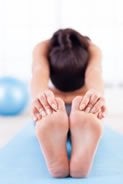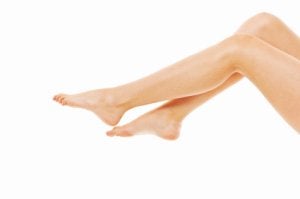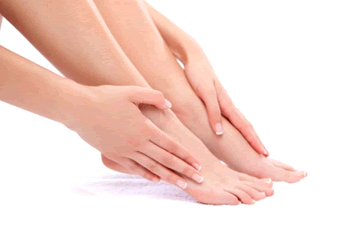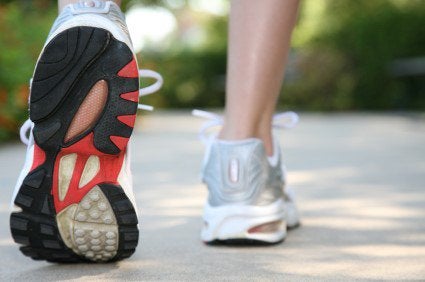-
Systemic Diseases of the Foot
There are several systemic diseases, or diseases that affect the whole body, that either display symptoms in the feet or affect the health of the feet. Common systemic diseases that affect the overall health of the feet, and the patient’s ability to walk comfortably, include gout, diabetes mellitus, neurological disorders, and arthritis.
In gout, which is caused by an excessive buildup of uric acid in the body, the most common symptoms of pain, inflammation, and redness occur at the metatarsal/phalangeal joint at the base of the big toe. Any excess levels of uric acid, crystallize and are deposited in tendons, joints, and surrounding bone and muscle tissue. Gout is commonly treated with NSAIDs to relieve pain and inflammation and other drugs to lower uric acid levels in the body. Gout most commonly affects those who are overweight, have low protein diets and lead a more sedentary lifestyle.
Diabetes mellitus is an increase in the level of blood sugar in which the body cannot counteract with naturally occurring insulin in the body. The three types of diabetes, Type I, Type II and Gestational Diabetes, are all signs the body is either not producing enough insulin or is not efficiently using the insulin that is produced. Gestational diabetes only affects women who are pregnant and have never, prior to pregnancy, exhibited symptoms of the disease.
There are two main issues that affect the feet that are commonly caused by diabetes. They include diabetic neuropathy and peripheral vascular disease. Diabetic neuropathy can lead to damaged nerves and affect the feet through numbness and loss of sensation. Peripheral vascular disease restricts the flow of blood to the foot and can, in extreme cases, lead to the necessity of amputating the foot. Peripheral issues that are caused by diabetes and can affect the foot include athlete’s foot, nail infections, corns, blisters, bunions, severe dry skin, plantar warts and ingrown toenails. These can all be attributed to the decrease of blood flow to the foot.
Neurological disorders and rheumatoid arthritis can also have severe impact on the health of the feet. Neurological disorders can affect the nerves in the main structure of the foot and cause loss of sensation and possible decreased muscle response. Rheumatoid arthritis can affect the bones and joint structures of the foot, making it impossible to walk normally without serious pain.
All systemic diseases that affect the foot can effectively be treated to minimize joint and muscle damage if they are diagnosed early and treated with medication and lifestyle therapy. Diabetes patients must monitor their blood sugar levels and work with their physician to keep their levels as close to normal as possible. Rheumatoid arthritis patients should work with their physician to ensure the proper medications are being taken to reduce the amount of damage to the joints of the body.
-
Study Finds Chemotherapy Induced Neuropathy Causes more Pain in Feet
 According to a study reported at the American Pain Society Annual Scientific Meeting chemotherapy induced neuropathy has been found to hurt more in the feet than in the hands making every day routine difficult. The study included 184 patients from the San Francisco Bay area completing taxane or platinum based chemotherapy where chemo-induced neuropathy was in their hands and feet. With the help of questionnaires such as the pain interference scale and brief pain inventory, chemotherapy induced neuropathy was found to cause treatment delay, decreased functioning of the feet, and poorer quality of life since the pain reduced everyday activities.
According to a study reported at the American Pain Society Annual Scientific Meeting chemotherapy induced neuropathy has been found to hurt more in the feet than in the hands making every day routine difficult. The study included 184 patients from the San Francisco Bay area completing taxane or platinum based chemotherapy where chemo-induced neuropathy was in their hands and feet. With the help of questionnaires such as the pain interference scale and brief pain inventory, chemotherapy induced neuropathy was found to cause treatment delay, decreased functioning of the feet, and poorer quality of life since the pain reduced everyday activities. When dealing with systemic disease of the feet, is extremely important to check the affected areas routinely so that any additional problems are caught quickly. For professional help, see Dr. Jon M. Sherman of Kentlands Foot and Ankle Center . Our doctor will ensure that your feet receive the care that they need.
Systemic Diseases of the Feet
Systemic diseases affect the whole body, and symptoms usually are displayed in the feet. This condition can make a patient’s ability to walk unbearable. Systemic diseases include gout, diabetes mellitus, neurological disorders, and arthritis.
Gout – is caused by an excess of uric acid in the body. Common symptoms include pain, inflammation, and redness at the metatarsal/phalangeal joint of the base big toe. Gout can be treated by NSAIDs to relieve pain and inflammation, and other drugs that lower the acid levels in the body.
Diabetes mellitus – is an increase in the level of blood sugar that the body cannot counteract with its own insulin. Failure to produce enough insulin is a factor in Diabetes.
Diabetes of the Feet
Diabetic Neuropathy – may lead to damaged nerves and affect the feet through numbness and loss of sensation.
Peripheral Vascular Disease – can restrict the blood flow to the feet, and often times lead to amputation of the feet.
If you have any questions feel free to contact our office located in Gaithersburg, MD . We offer the latest in diagnostic and treatment technology to meet your needs.
Read more about Systemic Diseases of the Feet
-
Bethenny Frankel of Real Housewives of New York Breaks Toe Jumping out of Bed
 Skinnygirl founder and Real Housewives of New York star Bethenny Frankel recently broke her toe while jumping out of bed. The 44-year-old took to Instagram to show off the bruised middle toe captioned, “This idiot broke her toe jumping outta bed, but a rough paddle race Saturday was not prob.” A few days prior Frankel participated in the Paddle & Party for Pink in the Hamptons, NY where she paddle raced for charity and did not sustain any injury. Additionally, Frankel’s surrounding toes were left unharmed and were taped alongside the broken toe to use as a splint.
Skinnygirl founder and Real Housewives of New York star Bethenny Frankel recently broke her toe while jumping out of bed. The 44-year-old took to Instagram to show off the bruised middle toe captioned, “This idiot broke her toe jumping outta bed, but a rough paddle race Saturday was not prob.” A few days prior Frankel participated in the Paddle & Party for Pink in the Hamptons, NY where she paddle raced for charity and did not sustain any injury. Additionally, Frankel’s surrounding toes were left unharmed and were taped alongside the broken toe to use as a splint. A broken toe can be very painful and lead to complications if not properly fixed. If you have any concerns contact Dr. Jon M. Sherman of Kentlands Foot and Ankle Centers . Our doctor will treat your foot and ankle needs.
What to Know About a Broken Toe
Although most people try to avoid foot trauma such as banging, stubbing, or dropping heavy objects on their feet, the unfortunate fact is that it is a common occurrence. Given the fact that toes are positioned in front of the feet, they typically sustain the brunt of such trauma. When trauma occurs to a toe, the result can be a painful break (fracture).
Symptoms of a Broken Toe
- throbbing pain
- swelling
- bruising on the skin and toenail
- the inability to move the toe
- toe appears crooked or disfigured
- tingling or numbness in the toe
Generally, it is best to stay off of the injured toe with the affected foot elevated.
Severe toe fractures may be treated with a splint, cast, and in some cases, minor surgery. Due to its position and the pressure it endures with daily activity, future complications can occur if the big toe is not properly treated.
If you have any concerns please feel free to contact our office located in Gaithersburg, MD . We offer the newest diagnostic tools and technology to treat your foot and ankle needs.
-
Everything You Need to Know About Gout
Gout, typically found in diabetic patients, is an unusually painful form of arthritis caused by elevated levels of uric acid in the bloodstream. The condition typically strikes the metatarsal phalangeal joint on the big toe; though it has been known to strike the knees, elbows, fingers, ankles and wrists—generally anywhere that has a functioning, moving joint.
The high level of uric acid in a person’s bloodstream creates the condition known as hyperuricema—the main cause of gout. Genetic predisposition occurs in nine out of ten sufferers and the children of parents who suffer gout will have a two in ten chance of developing the condition as well.
This form of arthritis, again noted as being particularly painful, is the leftover uric acid crystallizing in the blood stream and travel to the space between joints where they rub causing agonizing friction when the patient moves. Symptoms include: pain, redness, swelling, and inflammation. Tertiary side effects may include fatigue and fever though reports of these effects are very rare. Some patients have reported that, as the temperature drops (when you sleep for instance) the pain may intensify.
Most cases of gout are easily diagnosed by a podiatrist’s assessment of the various symptoms, however there are defined tests that can be performed. A blood test to detect elevated levels of uric acid is often used as well as the use of an x-ray to diagnose visible and chronic gout.
Treatment for gout simply means eliminating symptoms; non-steroid anti-inflammatory drugs or NSAIDs (Colchicine and other corticosteroid drugs, etc.) will quell the redness, the swelling, and the inflammation, however, diet, lifestyle changes, and preventative drugs are necessary to fully combat the most severe cases.
Those that lead a sedentary lifestyle are at a higher risk for gout. Any amount of exercise decreases probability of repeat encounters with the condition. Also, staying away from, or reducing drastically, consumption of red meat, sea food, and fructose-sweetened drinks reduces the likelihood of chronic gout as well.
As for diet, beyond what has already been mentioned, ingesting Vitamin C, coffee, and particular dairy products help on the preventative maintenance side of healthy living. While new drugs are out on the market that inhibit the body’s production of uric acid-producing enzymes, reducing or eliminating as much as possible your overall levels of uric acid will ensure you lead a gout-free life.
-
Rheumatoid Arthritis in the Feet
Although rheumatoid arthritis actually attacks multiple bones and joints throughout the entire body, ninety percent of people who actually develop this condition usually do so in the foot or ankle area. Those who develop this kind of arthritis in the feet usually develop symptoms around the toes and forefeet first, before anywhere else. Rheumatoid arthritis appears to have a genetic component. If it runs in the family, then you will be more likely to develop it as well.
Rheumatoid arthritis is an autoimmune disorder in which the body’s own immune system attacks the lining of the membranes surrounding the joints. This causes inflammation of the membrane lining, and the gradual destruction of the joint’s cartilage and even bone.
Some of the most common symptoms that are associated with RA include pain and swelling of the feet. Stiffness in the feet is also another common symptom that people experience. Those who have RA in the feet usually feel the pain in the ball or sole of their feet. This can get to be very painful at times. A person’s joints can even shift and become deformed after a period of time.
In order to properly diagnose RA in the feet it is usually necessary for a doctor or podiatrist to evaluate the area. Your doctor will also question you about your medical history, occupation, etc., to determine whether anything in your lifestyle may have triggered the condition. There are a number of tests that may be performed to help diagnose RA such as a rheumatoid factor test, although there is no one single test that will tell you for sure if you have RA. There are different X-rays that can be taken as well to determine if a person has RA in their feet.
There is a range of treatment options for rheumatoid arthritis. Treatment of RA is usually a lifelong process that includes a variety of methods of treatment and therapy. Your doctor can prescribe special shoes that should help with arch support as well as heel support. A physical therapist can help those with this condition learn exercises which will keep their joints flexible. Surgery may be needed to correct some of the issues with the feet, such as bunions, and hammertoes. Fusion is usually the most successful surgical option for rheumatoid arthritis. However, people need to keep in mind that there are some risks associated with these surgeries.
-
Key Rheumatoid Arthritis Symptoms to Look Out for
 Rheumatoid arthritis is a condition that tends to affect women more than it does men. Many people associate rheumatoid arthritis with its classic symptoms of joint pain and joint stiffness. Aside from these signs, however, there are another nine symptoms to be aware of: fatigue, slow healing, numbness, foot issues, eye trouble, joint ache, stiffness, locked joints, and nodules. Foot issues can include the development of pain in the heel, which is due to swelling tissue.
Rheumatoid arthritis is a condition that tends to affect women more than it does men. Many people associate rheumatoid arthritis with its classic symptoms of joint pain and joint stiffness. Aside from these signs, however, there are another nine symptoms to be aware of: fatigue, slow healing, numbness, foot issues, eye trouble, joint ache, stiffness, locked joints, and nodules. Foot issues can include the development of pain in the heel, which is due to swelling tissue. Rheumatoid Arthritis and joint pain can become very painful and debilitating if left untreated. For more information about Rheumatoid Arthritis and its symptoms, consult with Dr. Jon M. Sherman of Kentlands Foot and Ankle Center . Our doctor will assess your condition and provide you with quality foot and ankle treatment.
What Is Rheumatoid Arthritis?
Rheumatoid Arthritis (RA) is an autoimmune disorder in which the body’s own immune system attacks the membranes surrounding the joints. Inflammation of the lining and eventually the destruction of the joint’s cartilage and bone occur, causing severe pain and immobility.
Rheumatoid Arthritis of the Feet
Although RA usually attacks multiple bones and joints throughout the entire body, almost 90 percent of cases result in pain in the foot or ankle area.
Symptoms
– Swelling & pain in the feet
– Stiffness in the feet
– Pain on the ball or sole of feet
– Joint shift and deformationDiagnosis
Quick diagnosis of RA in the feet is important so that the podiatrist can treat the area effectively. Your doctor will ask you about your medical history, occupation, and lifestyle to determine the origin of the condition. Rheumatoid Factor tests help to determine if someone is affected by the disease.
For more information about rheumatoid arthritis please follow the link below.
If you have any questions, please contact our office located in Gaithersburg, MD . We offer the newest diagnostic and treatment technologies for all your foot care needs.
Read more on Rheumatoid Arthritis
-
How to Prevent Running Injuries
Many common running injuries are caused by overuse and overtraining. Several common injuries can occur due to running. When the back of the kneecap starts wearing away and starts causing pain in the knee, this is commonly referred to as runner’s knee. Runner’s knee can occur because of decreased strength in the quadricep muscles or shoes that do not offer proper support to the inside of the forefoot. Runner’s knee usually is treated with strengthening exercises focusing on the quad muscle and sports orthotic. To prevent runner’s knee, efforts should be focused on hip strengthening. Physical therapy is also beneficial in helping to learn the best exercises to heal runner’s knee. To prevent runner’s knee, strengthen the quad muscles to keep the kneecap aligned.
Overtraining is one cause of a common running injury called iliotibial band syndrome, which occurs when the iliotibial band gets irritated, causing pain and discomfort to the outside knee area. Another common running injury is known as plantar fasciitis, which occurs when the bone in the foot becomes inflamed and irritated. This injury primarily causes pain in the foot. Causes can include a high arch, incorrect footwear, tight muscles and flat feet. The best way to avoid plantar fasciitis is stretching and proper footwear.
Stress fractures are a common injury for runners. These fractures can occur because of overtraining, lack of calcium or running style. In runners, it is common for stress fractures to occur in several locations including the inner bone of the leg, the thighbone, the bone at the base of the spine and the toe bones in the foot. The best approach to preventing stress fractures are proper footwear maintenance and running on a surface with enough “give” to absorb some of the shock produced during running.
Besides overtraining, other causes of these common running injuries are poorly fitting footwear, irregular biomechanics, and lack of flexibility and strength. The best way to avoid running injuries is to prevent them. Fortunately, each of these common running injuries can be prevented. To avoid running injuries it is highly recommended to wear only footwear that fits properly and that suits your needs. Running shoes are the only protective gear that runners have to safeguard them from injury; therefore, choosing the correct footwear for running is important. It is important, too, to think about other aspects of your running routine like training schedules, flexibility and strengthening, and tailor them to your needs in order to minimize the possibility of injury. Regular stretching before and after running should be considered also when trying to avoid running injuries. Stretching keeps muscles limber resulting in greater flexibility.
-
Celebrity Runners Share Marathon Running Tips
 Celebrity runners such as Tiki Barber, Katrina Bowden, and Uzo Aduba recently shared their marathon running tips while training for the Airbnb Brooklyn Half Marathon, TCS New York City Marathon, and the Boston Marathon. “I’ll soak in an ice tub, do lots of stretching. And I get massages on a regular basis which helps a ton,” stated Tiki Barker on his recovery. Prone to plantar fasciitis, “30 Rock” star Bowden states, “I have to roll out my feet on a plastic ball every couple of days.” This helps ease the stabbing heel pain caused by the condition. Uzo Aduba of “Orange is the New Black” recalls overrunning and developing what she thought was a fracture in her foot. Since then she has learned to pace herself and slow down in order to progress.
Celebrity runners such as Tiki Barber, Katrina Bowden, and Uzo Aduba recently shared their marathon running tips while training for the Airbnb Brooklyn Half Marathon, TCS New York City Marathon, and the Boston Marathon. “I’ll soak in an ice tub, do lots of stretching. And I get massages on a regular basis which helps a ton,” stated Tiki Barker on his recovery. Prone to plantar fasciitis, “30 Rock” star Bowden states, “I have to roll out my feet on a plastic ball every couple of days.” This helps ease the stabbing heel pain caused by the condition. Uzo Aduba of “Orange is the New Black” recalls overrunning and developing what she thought was a fracture in her foot. Since then she has learned to pace herself and slow down in order to progress. Runners can still be prone to running injuries even with proper precautions. If you are suffering from a running injury see Dr. Jon M. Sherman from Kentlands Foot and Ankle Center . Our doctor will provide you with quality treatment and assist you with all of your foot and ankle concerns.
How to Prevent Running Injuries
Many common running injuries are caused by overuse and overtraining. When the back of the kneecap starts wearing out and starts causing pain in your knee, this is commonly referred to as runner’s knee. Runner’s knee is a decrease in strength in your quadriceps and can occur if you’re not wearing properly fitted or supporting shoes. To prevent runner’s knee, focusing on hip strengthening is a good idea, as well as strengthening your quads to keep the kneecaps aligned.
What Are Some Causes of Running Injuries?
– One cause of a common running injury is called iliotibial band syndrome.
– Plantar fasciitis is also another common injury.
– Stress fractures can occur from overtraining, lack of calcium, or even your running style.Best Ways to Prevent Running Injuries
– Wear footwear that fits properly and suits your running needs.
– Running shoes are the only protective gear that runners have to safeguard them from injury.
– Make a training schedule. Adding strengthening exercises as well as regular stretching can help keep you strong and limber and can lessen the possibility of injuries.
– Stretching keeps muscles limber, this will help you gain better flexibility.If you have any questions, please feel free to contact our office located in Gaithersburg, MD . We offer the newest diagnostic and treatment technologies for all your foot and ankle needs.
Read more about How to Prevent Running Injuries
RECENT POSTS
categories
- Uncategorized
- Featured Articles
- Foot Disorders
- Broken Ankle
- Broken Toe
- Fracture
- Foot Health
- Foot Care
- Arthritis
- Foot Pain
- Skin Cancer
- Podiatry Appointment
- Custom Orthotics
- Podiatrist
- Diabetes
- Gout
- Heart Health
- National Nutrition Month
- National Foot Health Awareness Month
- Foot Safety
- Foot and Ankle Injuries
- Falls Prevention
- Chronic Heel Pain
- Shoes
- Laser Therapy
- Quoted
- Physical Therapy
- KeryFlex
- Sweat
- Summer Foot Care
- Sports Injury
- ESWT
- Fungal Toenails
- Bunion
- Plantar Fasciitis
- PinPointe Laser


